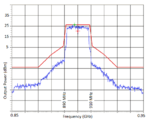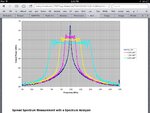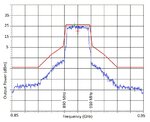Politecnico
Member level 1
Hi

The picture above is the RF signal (with central frequency= 0.9 GHz) with the LTE baseband signal (at 20 MHz).
Could anybody tell me, by having the plot at the Spectrum Analyzer, how we may calculate the total power of the signal throughout the whole bandwidth (over 20 MHz)
Thanks a lot for any hint, in advance
Politecnico

The picture above is the RF signal (with central frequency= 0.9 GHz) with the LTE baseband signal (at 20 MHz).
Could anybody tell me, by having the plot at the Spectrum Analyzer, how we may calculate the total power of the signal throughout the whole bandwidth (over 20 MHz)
Thanks a lot for any hint, in advance
Politecnico

